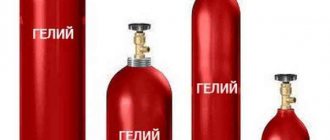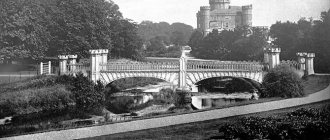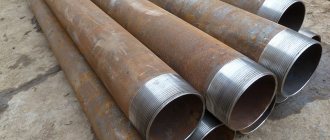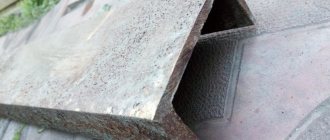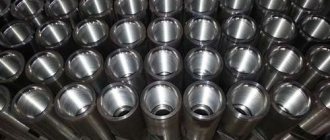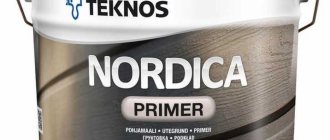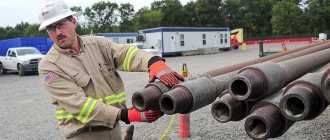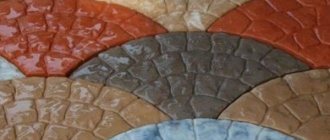Furniture fasteners, as their name suggests, are used to connect structural components of furniture. Its use reduces the cost of the production process compared to such complex mating techniques as dovetail or tongue and groove. In addition, the use of fasteners often makes it possible to avoid fastening elements of a furniture set with glue. And this makes transportation easier. After all, furniture can be disassembled and delivered to its destination on a regular minibus, and not on a specialized vehicle called a “furniture carrier.” In this form it is much easier to introduce it into houses, administrative premises - offices, and into apartments of modern multi-storey residential buildings.
MDF
MDF (finely dispersed fraction)
- medium density fiberboard (Medium Density Fibreboard, MDF) - a board material produced by dry pressing of fine wood chips at high pressure and temperature. Urea resins modified with melamine are used as a binding element. MDF is an environmentally friendly material with a low content of phenol-formaldehyde resins. During the production process, MDF can be given special properties: fire resistance, biostability, water resistance. The density of the material ranges from 600 kg/m³ to 800 kg/m³. MDF is mainly used in the production of furniture and for interior decoration.
MDF is well suited for the manufacture of speaker cabinets because it has a uniform structure, absorbs sound well and is easy to process. MDF is used in the manufacture of cabinets, in particular, facades, ideal for milling cavities of various depths, curved holes and other curved shapes. Most often, MDF is sold without coating. An example of the widespread use of MDF are laminated wall panels and the so-called laminate flooring type. For fastening MDF, self-tapping screws with partial threads or full threads can be used. The production of MDF boards is regulated by GOST 4598-86, according to which the thickness of the material ranges from 2.5 to 16 mm.
Coatings used
Furniture fastening fittings are used in the vast majority of cases indoors, which protects them from the harmful influences of the environment. However, all metal elements made of steel subject to corrosion are subject to special treatment:
The above technologies for applying zinc and copper alloys to fasteners are designed to provide higher performance and decorative qualities. Screw elements made of aluminum are almost never coated with protective compounds, due to the properties of the material from which they are made.
Galvanized
Brass
Confirmat
It is a direct descendant of self-tapping screws for a knife screwdriver, who liked to hammer in correctly instead of carefully screwing in. Using the confirmation will not cause problems even for an inexperienced user. It is a self-tapping screw that has an increased diameter and is also not equipped with the usual tip. The furniture confirmat is designed for use with a special hexagonal nozzle. You can't screw it in with a regular Phillips screwdriver. Such fasteners have become especially in demand with the growth in the production of cabinet furniture. The latter is assembled from laminated chipboards using facades or MDF inserts.
With the help of the confirmat, two furniture parts are fastened only at an angle of 90 degrees. If a different angle is required, then fasteners are used, which will be discussed below. Since the confirmat does not have a sharp tip, it cannot simply be screwed into wood. Before assembly, holes are drilled in the parts. Near the head, the confirmat has a slight thickening, which requires the use of a 6 mm drill. For the threaded part you will need a consumable with a diameter of 5 mm. It is most convenient to use special drills for confirmations. They are a small crown or cone into which a 5 mm drill is inserted. As soon as the drill is completely recessed into the material, the cutter makes a slight expansion under the head of the furniture fastener.
This is done to hide furniture fasteners with special plastic or other covers. Usually the furniture board is 16 mm thick, so the hole is drilled at the end in the middle. If a hole is drilled in a furniture board from the front part, then an indent of 8 mm is made from the edge in order to smoothly join the parts.
Confirmats can be used in conjunction with other fasteners, for example, dowels. This is done for a more durable joining of furniture parts. It is worth understanding that the fixation of furniture parts can be ensured at the highest level only during the first assembly. If you frequently assemble and disassemble furniture, the confirmators will not be able to fix the parts with the required rigidity. When screwing in furniture fasteners, it is necessary to select the correct force. If it exceeds the required limits, then the confirmat will simply begin to scroll or damage the second part.
Those who have been working with cabinet furniture for a long time have learned to feel the tool and avoid deforming parts by excessive tightening.
Fastener categories
If half a century ago the main elements for assembling furniture components were wooden dowels, and installation of various pieces on site was carried out using nails or screws, today the range of accessories for connecting individual parts and furniture elements has expanded significantly.
Modern fastening and connecting parts can be divided into several categories, including both highly specialized products and universal fittings:
- threaded furniture fasteners are a classic combination of two parts - a screw-nut, which are sometimes supplemented with washers to reduce specific loads;
- a confirmat (euroscrew) is a screw fastener whose threads are similar to screws or self-tapping screws, which can significantly speed up the assembly process;
- eccentric couplers are used to speed up adjustment and in cases where it is necessary to avoid the visibility of individual fastening elements;
- Traditional dowels and corners, which have long been used to connect individual panels of furniture, have also not lost their popularity.
mebelnye-ugolki mebelnyj-jekscentrik konfirmat rezbovoy-mebelnyiy-krepezh
The most common types of furniture fasteners
Let's consider the most common groups of connecting and fastening fittings for furniture, the features of their installation and operation.
Screws with a semicircular or decorative head and bolts with a fixing mustache or square head are the main types used for fastening individual panels of frame furniture. Thanks to the fixing mustache or square head, the bolt (screw) is fixed in the hole of the particle board, which prevents it from turning. Due to this design feature, the assembler has the ability to tighten the nut without additional fixation of the screw.
Universal screws with a countersunk or semi-countersunk head have slots of various shapes (cross, hexagon socket, straight slot and others) and are intended for fastening individual assembly parts inside furniture structures. They are used for:
- installation of facades, rear walls,
- fastening of drawer guides;
- installation of mounting angles;
- fastening of any furniture fittings, from roller supports to locks and drawer handles;
- manufacturing combined parts - for example, countertops from two sheets of MDF boards.
On a note! When using universal screws, either screwdrivers with replaceable bits or sets of screwdrivers with replaceable tips are used.
Confirmats (Euroscrews) in modern furniture production are the most popular type of fastening and fixing devices. This type is used for fastening any parts made of chipboard or MDF panels.
Before screwing in the Euroscrews, holes are pre-drilled in the parts using a special confirmatory drill, the diameter of which depends on the diameter of the fixing element. To screw this type of fastener, either a screwdriver with special bits or screwdrivers with seed attachments are used. The type of bit or attachment depends on the type of slot.
Eccentrics are another fitting, bearing the somewhat exotic name of rasteks and minifixes, which allow you to connect and attract panels located at right angles to each other. Despite the obvious advantages of this category of fasteners, their main disadvantages are:
- the need for additional milling of furniture panels to install individual fasteners;
- relatively high cost.
- high precision of marking and difficulty in installing individual fasteners;
On a note! To install individual minifix parts, you will need three different types of woodworking tools - one end mill and two drills of different diameters.
Furniture corners have proven themselves to be a reliable, easy-to-install element. Today they can be made either of metal or of special, high-strength plastic. In the industrial production of cabinet furniture, the color of the plastic corner is matched to the color of the furniture.
Modern furniture dowels are made of wood, plastic or metal. Their main advantages are the low cost and ease of connecting furniture parts together. To increase the reliability of the connection, there is a corrugation on the surface of the dowels.
Features and Benefits
The confirmat is a screw with a countersunk head with two types of slots - for hex and tetrahedral tools.
Its rod has a blunt end and is equipped with a massive, widely protruding thread, the lower turns of which are conical with notches, designed for cutting threads in the material.
Under the head of the screw, the rod has a smooth, unthreaded area.
Euroscrews are made from high-quality carbon steel and equipped with nickel, zinc or brass coating.
The steel used for the production of Euroscrews is ductile, so they bend, but do not break if installed incorrectly, which makes them easy to remove from the material.
A single-element screed is designed for connecting parts made of wood and materials created on the basis of woodworking products - chipboard and MDF panels.
The size range of this fastener is presented in the following ratios of outer thread diameter and screw length (mm): 5x40, 5x50, 6.3x40, 6.3x50, 7x40, 7x50, 7x60, 7x70.
The most popular ones include confirmations with a length of 50 and 70 mm with a thread diameter of 7 mm.
Euroscrews with a regular head require additional countersinking of the hole to place the head flush, but they are also available with a small tooth under the head, which provides the hole with a chamfer of the desired size simply during installation.
If the confirmation is mounted on the front surface of the furniture body, then today a wide selection of decorative plugs and stickers are offered to mask the screw heads, which can be selected in accordance with the decor of the furniture material.
Nuances of fasteners
Despite the versatility of this fastening element and the ease of working with them, a certain skill is required, mainly associated with knowledge of the characteristics of a particular material to be installed.
Holes for confirmations can be made using drills with a diameter of 4.5-5 mm for the screw rod, and a hole for the head is made with a special stepped cutter attached to the drill.
The last option is the most convenient, as it allows you to prepare holes in one pass.
To make a quality hole, it is better to use a high-speed tool. At low speeds, the drill can pull the wood and become clogged with chips that will not be completely removed from the hole.
The cutter makes perfect holes; when removed, the drill leaves small chips along the edge of the holes, which in this case is not critical, since they will be covered by the screw head.
Euroscrews provide more reliable connections than other types of fasteners due to the wide protruding threads that firmly cut into the material.
Confirmations are installed using a screwdriver or drill with the appropriate bits or hand keys.
For beginners, it is better to install manually in order to control the process, and in case of excessive resistance of the screw during installation, remove the fastener in time, avoiding mechanical damage to the material.
How to choose bits for a screwdriver
To make it easy and convenient to work with a screwdriver, you just need to choose the right bits.
At the same time, it is advisable to choose high quality products, even if their cost may be a little overpriced.
Before purchasing, you should study the recommendations for choosing bits from experts.
Recommendations
When choosing piece products, you need to pay attention to:
1. Material
It is better not to purchase steel products, since this material may not withstand increased loads.
2. Integrity of the working part
The bat should be one piece and not consist of several parts.
Otherwise, during intensive work it may simply fall apart.
3. Availability of protective coating
This is the most important criterion for bit selection.
To ensure that the product lasts as long as possible, it is recommended to choose it with titanium coating.
Such a bit will be able to screw in a large number of screws and will not fail after the first use.
Products coated with diamond, nickel or a nickel-vanadium alloy are also considered good.
Nozzles without a protective layer may become rusty.
It is recommended to buy such products exclusively in specialized stores, although you can purchase them at a low price at various flea markets.
But such a risk is justified only in the case when the work needs to be completed as quickly as possible (for example, on Sunday you urgently need to tighten the screws, and all the shops are already closed) and they will not last long.
They are not suitable for permanent use.
Bit sets
Sets of bits are especially popular, since it is possible to purchase products that are suitable for all occasions.
If you want to be the best, bit sets will always help you out.
When choosing, you need to focus on:
1. Types of bits included in the kit
They can be divided into 5 main types, each of which must be present in the set.
Some kits may also contain highly specialized attachments, for example, star-shaped or with anti-vandal slots.
2. The metal the bits are made from
It must be of high quality.
A protective coating on each bit is welcome.
This will allow you to use the product for a long time.
This is especially important for sets of professional attachments. 3
Brand reputation
3. Brand reputation
It is better to purchase products in specialized stores.
However, remember that a good kit is never too cheap.
Using high-quality bits for an electric screwdriver can guarantee the successful completion of construction and repair work.
The correct choice of bit for a screwdriver should be based on the type of work required.
When choosing, you should also pay attention to the name of the company, because a manufacturer who monitors the quality of its products will certainly inspire the trust of specialists. This means that this company has proven itself best in the construction and repair sectors.
This means that this company has proven itself best in the construction and repair fields.
The following brands are considered the most popular and reliable in the ranking:
1. WhirlPower
It is a manufacturer of budget products. Produces bits with lengths from 25 to 250 mm.
2. DeWALT
The brand is characterized by a high level of impact resistance and the absence of mechanical defects on the working half, while the characteristics are maintained throughout the entire service life.
3. Magna
The company offers high-quality products for little money, so thrifty owners choose products from this brand.
4.Bosch
A world-famous brand that produces products with high performance characteristics.
Metabo products are also available on the construction market, but judging by user reviews, their reliability is questionable.
Most often, complaints are made about the strength of the ribs, which is insufficient.
Even with a small force when screwing in a self-tapping screw (sometimes you can’t do without it), the fastener head is almost immediately deformed and the slot is cut off.
Types of dowels for drywall profiles
Dowels for profiles are fasteners used in the installation of guide profiles and hangers for the frame under gypsum boards.
There are:
- dowel nail;
- dowel-wedge (anchor);
- butterfly;
- wood;
- Knauf-Hartmut;
- Fischer Pd";
- umbrella;
- chemical anchors.
The main types of dowels used when installing the frame base
To understand which dowel should be used in a certain situation, all options are discussed below.
Dowel-nail for drywall profile
The most common fastener for mounting the gypsum board frame. According to the method of fastening, there are two types: manual driving and using a mounting gun.
The second type is a fastening element consisting of a nail and a washer. Used for installation of heavy massive structures to a concrete base.
This type of fastening element is not applicable for working with gypsum plasterboards
I mark products by size. Dimensional characteristics indicate the diameter of the base and the length of the nail. When working with a profile for drywall, the optimal option is 6/40, 6/60 mm, where 6 is the diameter, 40 and 60 are the length. They are used to fix guide profiles to the rough base, and also fix direct hangers.
Dowel-wedge
A wedge or anchor wedge is a reliable fastening element. Dowel for fastening profiles on concrete and solid brick walls. Withstands heavy loads. Fastening is possible even at a short distance from the edge of the base. They produce anchor wedges ranging in size from 8/45 mm to 16/150 mm.
Fasteners are used for through-hole and pre-installation
Butterfly dowel
According to dimensional characteristics, they are distinguished:
- 8/28 mm. The smallest, suitable for attaching light objects. Self-tapping screws are not included. Must be purchased separately, size 3.5 x 35 mm.
- 10/50 mm. Self-tapping screws with dimensions 3.5 x 55 mm. Withstands loads up to 24 kg. Suitable for fastening furniture shelves and cabinets.
- Metal butterfly dowel. The second name is Molly. Suitable for use on walls made of hollow materials. Size range from 4/21 to 6/80.
By following all the rules for fastening, “butterflies” serve as strength for a long time
You can learn more about the sizes and types of butterfly dowels on our website.
We recommend watching a video about the process of attaching the butterfly.
Driva
They produce two types of hardware: with and without a drill, made of nylon and metal. To hang heavy objects on a plasterboard surface, use a galvanized part.
The shape is a cone-shaped cylinder. The thread pitch is large. A flat-shaped hat with a cross-shaped slot. Used when installing small-sized, lightweight structures. Dimensions 12 x 38, 12 x 42, 14 x 38, 15 x 29.
Knauf-Hartmut
The fastener consists of:
- U-shaped profile;
- plastic antennae and bushings;
- screw with dimensions 5/60 mm.
Principle of operation:
- drill a hole in the wall;
- insert the profile plate into the hole using guide antennae;
- break off the antennae;
- screw in the screw.
Withstands loads up to 55 kg.
Fastening element for mounting heavy objects
"Fischer Pd"
Fastening device for working with drywall and profiles. Plastic cylinder with sleeve and side blades. Principle of operation:
- drill a hole, the diameter is equal to the dimensions of the sleeve;
- insert fisher;
- secure with a screw.
The mount can support up to 16 kg. Sizes – 10/28.
When fixing, the side blades should be open and pressed to the base from the back
Umbrella
It got its name because of the principle of operation. After fixing in the hole, the side blades unbend and the fastener looks like an open umbrella. This promotes load distribution and the ability to withstand heavy weight.
Chemical anchors
It is a cartridge with a capsule containing an adhesive liquid. When mechanically applied, the capsule bursts and the glue gets into the hole.
Due to its properties, it is a monolithic fastener that can withstand heavy loads
Dimensions
In this sense, it is easier to focus on the table when choosing screws. There are columns such as M4, M5, M6, M8, M6x30, various parameters like 8x35 and others. M is the thread indicator; the table below shows the minimum and maximum values for this indicator, as well as the nominal dimensions.
If you don't want to look at the table, here are a couple of examples:
In construction markets, furniture fasteners are sold in a separate block, where all options and standard sizes are divided into sections. The consultant will help you navigate the assortment.
Fastening parts with self-tapping screws
If a self-tapping screw is used to fasten two parts, pressing one part to another, then in the part (hereinafter we will call it the upper one), which will be on the side of the head, you need to drill a hole of such a diameter that the screw to be screwed in easily fits into it without rotation, but does not dangle in him. We measure the diameter of the screw along with the thread using a caliper and drill a hole of this diameter. In addition, you can make a recess for the cap. Now we fold the parts the way they should be secured and screw in the self-tapping screw in accordance with further recommendations. Thus, the self-tapping screw, freely passing through one part and being fixed in another, will press the parts one to another. A common mistake is not drilling the top piece or drilling with a drill bit that is too thin. The self-tapping screw does not slide freely into such a hole. It is fixed in the upper part and cannot press one part against another. A gap remains between the parts, the strength and quality of the connection drops significantly.
Purpose
When assembling a furniture product, the location of the connected parts of the structure must be checked so that its integrity is not compromised during operation. This is what a furniture tie is intended for - a fastener that makes it possible to tightly and firmly connect structural elements located in a certain position (most often at a right angle) relative to each other. If previously furniture was assembled mainly using screws and self-tapping screws, now different types of ties are used for this.
This replacement is due to three reasons:
- Increasing the aesthetics of furniture, thanks to the use of ties, the fastening of parts becomes invisible;
- Each disassembly of furniture assembled with screws reduces reliability;
- Sometimes the use of conventional fasteners is simply impossible for structural reasons.
And finally, the use of furniture ties allows for quick and durable assembly of the product.
Stubs
For an aesthetic appearance of assembled furniture, fastener caps can be hidden with plugs. They are used to create a complete look; they have a purely decorative function. Plugs can also be used to hide small defects during assembly, especially on the front and front sides of furniture.
The following types of plugs are distinguished:
- Self-adhesive. Used when it is necessary to hide a screw with a straight head. The craftsmen then select a decorative element of a suitable color shade.
- Plastic. Installed on any type of screws.
- Wooden. They are more expensive and are intended for luxury solid wood furniture; they may require painting to match the color.
The shape of plastic plugs can be round with different diameters or polygonal (square or rectangular are more often used). There are a lot of color solutions for similar elements
When manufacturing them, the main color options of laminated chipboard and MDF are taken into account. The cost of all types of plastic plugs is almost the same; in stores they are offered in packs of 10 pieces
They can have different cap diameters and are selected to suit your taste. These elements are held on the hexagonal protrusion provided by the euroscrew
It is very important that the plug is attached to the confirmat with some force, then it will be securely fixed and will not fall off
What is this
This type of fastening is affordable and very reliable. For built-in pieces of furniture, it will serve as the main connection, which can be safely called universal. The only thing is that after installation work it will be clearly visible and does not always have a beautiful appearance. Plastic products look visually great, but they can withstand smaller types of loads. No new holes are required for their installation.
Installation work is carried out using self-tapping screws. The corners have the simplest possible design. This is a bent metal plate, where the bend is an edge, and the edges are shelves. The products have an unusual color or shape. They are used to make internal types of connections or find use for them as decorative fittings. Let us highlight several types of corners that are installed using nails, euroscrews or standard screws.
Varieties
The more popular and popular samples used in the production, assembly, and installation of furniture include:
- universal screw;
- confirmation
Also in the furniture industry, a number of characteristic screws are used that have blunt ends, large threads adapted for chipboard, and specific heads. One such product is a galvanized steel screw that allows you to attach chipboard sheets at a 90-degree angle.
Universal screw
Confirmat
Universal screw
The product is presented in the form of a cylinder-shaped rod with various types of heads and external threads. Its main task is to fasten individual assembly elements inside furniture structures. The upper part of this screw can have different shapes:
- the countersunk head of the product, which, after screwing, is completely recessed and does not protrude above the materials being fastened, its scope of application is the installation of shelves, handles, hinges, guide runners for drawers;
- the semi-countersunk head, due to the smooth transition from the rod to the thread, at the moment of twisting, goes into the material, as well as the mating part;
- semicircular head, the horizontal plane and the inner base of the surface of the semicircular head of which, during installation, additionally creates pressure on the material being fastened, increasing the strength of the structural unit, thereby eliminating its deformation.
The presence of a special thread makes it possible to easily attach the screw even to the hardest types of wood. Hardware splines can be simple or cross-shaped. Products with a cross-shaped slot have a number of irrefutable advantages:
- a screwdriver or drill is instantly fixed in the head;
- You only need one screwdriver;
- The installation process in hard-to-reach places is carried out without much effort.
When using universal screws, you must equip yourself with a screwdriver and screwdrivers with replaceable bits. To ensure a high-quality connection of materials, you should drill holes during the process of screwing in the screws, the diameter of which will be 70% of the thickness of the hardware, and also choose the right drill.
Confirmat
These products have another name - Euro-screws, which in modern furniture production are considered a more popular type of fastening and fixing devices, as they are among the most reliable, inexpensive furniture connections. Such products are resistant to mechanical stress and fracture.
Confirmat is used for joining structures made of materials such as wood, chipboard, multi-layer plywood, chipboard. In many cases, screws with dimensions of 5x50 mm and 7x50 mm are used. In addition to fastening parts, euroscrews replace a regular angle, performing a body-forming function, while withstanding all bending loads. To make cabinet furniture look aesthetically pleasing, confirmations are complemented with plugs made of plastic. They disguise a noticeable part of the hat to match the color of the furniture product.
Distinctive features of these fasteners are large threads, a blunt tip, a cylindrical head, and a hexagonal slot. When assembling structures, furniture hexagon screws do not require special skills or specialized equipment.
Flat connection plates
Like pins, flat connector plates can be used as furniture fastenings.
- They work on the same principle, where two parts are connected to each other by inserting a fastener into drilled holes.
- With their help, you can fix them in the shape of the letter T, L or create a single plane.
- Thanks to their shape, the plates can move in the groove and thus lock better, while at the same time their surface area is larger due to the shape and the resulting adhesive joints are stronger.
Like pins, inserts are available in a variety of sizes that are used depending on the thickness of the wood - type 0 for wood 10-12mm thick, type 10 for wood 13-15mm thick and type 20 for material over 16mm thick. mm.
Fiberboard
Fibreboard (fibreboard, hardboard))
- a single-layer slab material, which is produced by hot pressing of a mass consisting of cellulose fibers, water, special additives and synthetic materials. There are 2 types of fiberboard: soft and hard. This characteristic is reported using special markings in the form of the letters “M” and “T”, respectively. The raw material for fiberboard is wood chips in split form, as well as crushed wood.
In order to improve the performance in the production of such boards, paraffin and rosin are added, which increases moisture resistance, as well as synthetic resins, which is done to strengthen the fiberboard, and antiseptics. As a rule, fiberboard on one side is always a perfectly flat surface, which is achieved by using varnish, special film or plastic. Fibreboard is subject to significant warping when exposed to moisture, thin sheets
Fiberboard does not withstand impact loads well. Fiberboard is used in low-rise construction and in the furniture industry. To fasten fiberboard, self-tapping screws with partial threads or full threads can be used. The thickness of fiberboard according to GOST 4598-86 ranges from 2.5 to 16 mm. The main advantage of fiberboard is the price.
For the manufacture of furnishings, various elements for connecting parts are used. Self-tapping screws are a popular type of fastener that has its own undeniable advantages. They are especially often used for assembling cabinet furniture, ensuring a sound and durable connection of structural parts.
Self-tapping screws are a popular type of fastener that has its own undeniable advantages.
Types of self-tapping screws: characteristics, features, properties, application, recommendations of specialists
The word “self-tapping screw” has been around for a long time and most of us know very well in general terms what it is. Many people actively use them for repairs, construction work and just in everyday life. In stores they are sold by weight, but large options are purchased individually.
Secondhand stores offer a huge selection of self-tapping screw elements (the official designation of fasteners) in shape, material, size, purpose, etc. Naturally, a lot of pressing questions arise on this topic - How? For what? What? What are they? How?
To clarify and sort everything into “information” shelves, let’s take a closer look at this important topic.
When purchasing self-tapping screws, every competent buyer focuses on very specific tasks that these items should solve. Initially, a logical parallel can be traced - for metal a self-tapping screw for metal should be used, for roofing - a roofing screw, and for wood - accordingly for wood.
So, the basic classification has begun, let’s proceed to a detailed study of the types of self-tapping screws.
Installation
Material calculation
The total number of euroscrews depends on the mounting area. You can count them yourself. The main thing to consider is the following information about fastening hardware.
When drilling holes, you must strictly maintain the edge and center distances.
- The minimum distance from the edge is equal to twice the depth of the fastened element. The fastening element cannot be installed very close to the edge.
- The maximum distance between the axes is equal to four times the depth of the material being fixed. You shouldn’t screw in Euroscrews further than this value.
Often buyers have difficulty, they cannot decide on the number of pieces. Since the manufacturer sells confirmations by weight.
- In this case, special calculators available on the Internet will help. If you enter the type of hardware, standard, diameter, length and weight into the program, it will calculate how many kilograms of hardware are in the specified quantity.
- There is another calculator in which you just need to indicate the size of the screws and the weight, and it will give you the number of pieces. There is also a reverse calculation (from pieces to kilograms).
Below we will tell you which drill is suitable for the confirmat and how to install them.
Jig for drilling holes for confirmation
Technology
Connecting parts with a confirmat requires little skill. You need to be familiar with the features of the European screw and the quality of the material being fastened. Confirmat is used mainly for fiberboard, chipboard, plywood, chipboard and wood.
The connection is formed as follows: the smooth part and the head are in the through hole, and the threaded part is in the blind hole. In this case, the first hole is a through hole, which is located on the front part of the first part. And the second hole is in the second part and it is blind.
The installation process looks simple. For confirmation you need to prepare 2 special holes: the first for the threaded part, the second for the smooth unthreaded part. If we take as an example the most common confirmation size of 7 mm, then in this case you will need a 5 mm drill for the threaded part, and a 7 mm drill for the non-threaded part.
- There is another positive point in editing the confirmat. There is a special drill for confirmat, which has a stepped thread. With its help, you can prepare a hole for a European screw in one step.
- To connect the parts even more securely, a dowel is added to the fastening.
So, to fasten the parts with a confirmant, you will need the following tools:
- Hexagon.
- Two drills of different diameters (5 and 7 mm) or a confirmation drill.
No. 2. Scope of application of furniture bolts
Where else could furniture bolts be used if not in the furniture industry? That's right. The main purpose of this fastener is to connect furniture parts, but the convenient design with a semicircular head was highly appreciated by builders and began to be used in other areas.
Currently, furniture bolts are used for the following purposes:
- in the production of tables, chairs, sofas, beds, cabinets, chests of drawers, kitchen sets and other furniture;
- when repairing furniture, when replacing old bolts is required. By the way, when moving, furniture can be disassembled by unscrewing some of the fasteners, and assembled in a new place using existing bolts, because they are not disposable;
- for connecting wooden parts in private construction and repair, for example, when creating stairs and gazebos;
- in some other areas (mechanical engineering, road work, bridge construction, door lock production), when it is necessary that the height of the cap be minimal, and the area itself is not responsible.
What are they?
Like any fastener, the dimensions of a self-tapping screw are their diameter and length. To ensure that when purchasing in different stores, the buyer does not purchase different products using the same markings, all self-tapping screws must comply with certain dimensional standards. For European manufacturers this is:
- DIN – German standard;
- ISO – international standard;
- GOST is a domestic standard.
In many ways, these three standards coincide, although they have their own nuances. The manufacturer in the product description is obliged to indicate characteristics in accordance with one of them. And in order to make it easier to standardize self-tapping screws by size, they are divided into several types.
On wood
The main difference between such self-tapping screws is the rather large thread pitch. This is explained by the low density and hardness of wood, which makes it possible to produce thinner and longer hardware (from the words “metal products”). Their length varies widely from 11 to 200 mm, and their diameter from 2.5 to 6 mm. The harder the wood, the larger the size of the fastening element you have to select. Most often, self-tapping screws for woodworking are called universal. When making home repairs, to secure baseboards, socket boxes or hang a shelf on the wall, the most inexpensive self-tapping screws with plastic dowels are enough.
In cases where the material is too dense, a hole is drilled before attaching it to a self-tapping screw. In order not to spoil the structure, you should carefully select the diameter of the drill. This can be done using a small table.
| Self-tapping diameter | Drill diameter |
| 4.0 mm | 2.5-3.0 mm |
| 4.5 mm | 3.0-3.5 mm |
| 5.0 mm | 3.5-4.0 mm |
| 6.0 mm | 4.5 mm |
For metal
Self-tapping screws for working with metal are somewhat different from those intended for wooden structures. Their length ranges from just 9.5 to 75 mm, and their diameter starts from 3.5 mm and ends at 4.2 mm.
With press washer
Such elements can be called universal, because they are used for fastening wood, metal, plastic, siding and many other materials. Their distinctive feature is a large cap, which is called a press washer. With its help, it is possible to press the structure being fixed more tightly without using additional washers. Their length ranges from 13 to 64 mm, and their diameter is always 4.2 mm.
Roofing
Self-tapping screws used to fasten strips of corrugated sheets, metal tiles and other types of roofing have a length of 19 to 100 mm, and a rod diameter of 4.8 to 6.3 mm
Instead of a regular cap, they have a large washer with a rubber gasket that does not allow water to pass through, which is very important when installing a roof. However, they are often used to fasten other structures, for example, a fence made of corrugated sheets or a metal garage door frame
Furniture
Such self-tapping screws are called “confirmations”; they are used in assembling various furniture. Their length ranges from 40 to 70 mm, and their diameter ranges from 4.72 to 6.05 mm. Such self-tapping screws always require preliminary drilling of the intended holes with a special confirmatory drill; tighten them with a special hexagon, and not with a regular screwdriver.
"Capercaillie"
Such fasteners are used for the installation of heavy structures, where high strength and reliability are especially needed, for example, in the construction of interfloor ceilings. Their length is usually 40 mm, and their diameter starts from 6 and ends at 10 mm. The hex head is tightened with a regular wrench or a special screwdriver attachment.
Types of Pin Connections
We differentiate between blunt connecting pins, straight connecting pins and angled connecting pins.
- For corner connections, straight or corner pins are used. They are mainly made from beech wood, with a diameter of 6 to 20 millimeters, with a smooth or already grooved surface.
- Ideally, the pin should be a harder wood than the material being joined. The finished pins already have chamfered ends to make it easier to work with during connection.
- If you are making the pins yourself, also carefully cut off both ends and sand them. Slotted pins can be straight or spiral and are called grooved pins.
Due to the expanding properties of wood, the pin is held very tightly. In addition, the grooves allow the pin to be distributed more evenly across the entire pin area when using adhesive.
Usage
Due to the fact that the most common type of furniture screws is the confirmat, using its example you can see how to tighten the screw correctly.
Let's consider the operating algorithm.
The following video talks about furniture joining.
Shelf supports
There are a huge number of types of shelf supports. However, they can be divided into two groups: shelf holders for chipboards and shelf holders for glass. In turn, each of these groups can be divided into two types: shelf holders with and without fixation.
The shelf holder for chipboard consists of 2 parts: a rod and a shelf holder.
The screw is installed in the cabinet wall, and the shelf holder is installed in the body of the shelf. To install the shelf holder, you need to drill holes in the shelf and cabinet wall. For most shelf supports, the hole sizes are standardized; they are shown in the figure below. However, when installing the shelf support, you should carefully read the instructions to avoid errors.
It should be noted that shelf holders for chipboard come with or without fixation. The shelf holder with fixation has an eccentric mechanism, thanks to which the shelf will be firmly connected to the cabinet wall. Shelf supports with fixation have one more advantage; shelf supports of this type serve as additional reinforcement of the furniture structure.
Glass shelf holders have a simpler design. They are attached only to the cabinet walls using a self-tapping screw.
Shelf holders for glass without fixation are a rod or an angle. Shelf holders with fixation have a special screw with which the glass is firmly fixed and cannot accidentally fall out.
